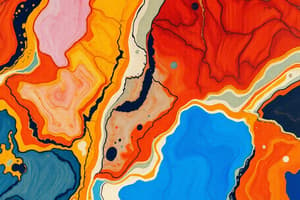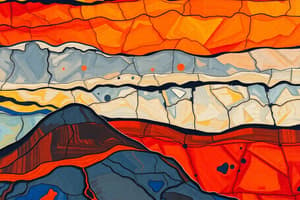Podcast
Questions and Answers
Which type of rock can become an igneous rock through subduction and uplifting processes?
Which type of rock can become an igneous rock through subduction and uplifting processes?
- Sedimentary rock
- Basalt
- Granite
- Metamorphic rock (correct)
What type of metamorphism generally occurs next to igneous intrusions under the surface?
What type of metamorphism generally occurs next to igneous intrusions under the surface?
- Hydrothermal metamorphism
- Contact metamorphism (correct)
- Dynamic metamorphism
- Regional metamorphism
Which type of metamorphic rock is formed from shale or mudstone?
Which type of metamorphic rock is formed from shale or mudstone?
- Marble
- Gneiss
- Schist (correct)
- Granite
What are hydrothermal fluids?
What are hydrothermal fluids?
What geological processes can cause extreme accumulations of sediments and the underlying layer to sink into the crust?
What geological processes can cause extreme accumulations of sediments and the underlying layer to sink into the crust?
What are the three types of rocks in the rock life cycle?
What are the three types of rocks in the rock life cycle?
How do igneous rocks form metamorphic rocks?
How do igneous rocks form metamorphic rocks?
What can sedimentary rocks be transformed into?
What can sedimentary rocks be transformed into?
What is the starting point for the formation of rock from molten lava or magma?
What is the starting point for the formation of rock from molten lava or magma?
How long can rocks take to form or change types according to the text?
How long can rocks take to form or change types according to the text?
Which process initiates the sedimentary rock cycle?
Which process initiates the sedimentary rock cycle?
What are the processes that bind accumulated sediments together known as?
What are the processes that bind accumulated sediments together known as?
What are the three types of sedimentary rocks?
What are the three types of sedimentary rocks?
What are clastic rocks formed from?
What are clastic rocks formed from?
How can sedimentary rocks transform into other rock types?
How can sedimentary rocks transform into other rock types?
Study Notes
The Rock Cycle and Sedimentary Rocks
- The rock cycle can transform metamorphic rocks into sedimentary rocks through weathering, erosion, and cementation, or into igneous rocks through melting and crystallization.
- Each rock's life cycle is unique and can involve one or all three rock types, or go back and forth between types.
- The rock cycle is a model of how rocks are created, altered, and destroyed over time.
- Sedimentary rocks form from sediments that are broken off other rocks and cemented back together.
- Weathering, caused by various processes, initiates the sedimentary rock cycle.
- Erosion, primarily caused by water or wind, moves broken rock pieces away.
- Deposition is the process where eroded sediments are transported and accumulate.
- Compaction and cementation, known as lithification, are the processes that bind accumulated sediments together.
- There are three types of sedimentary rocks: clastic, organic, and chemical, each with distinct formation processes and compositions.
- Clastic rocks are formed from clasts, while bioclastic rocks contain particles from once-living matter.
- Organic rocks are the lithified decomposed remains of plants and animals, while chemical rocks form from precipitates in water.
- Sedimentary rocks can transform into metamorphic or igneous rocks through specific geological processes.
Studying That Suits You
Use AI to generate personalized quizzes and flashcards to suit your learning preferences.
Description
Explore the fascinating world of sedimentary rocks and the rock cycle with this quiz. Test your knowledge of how sedimentary rocks form, the processes involved in the rock cycle, and the different types of sedimentary rocks. Learn about weathering, erosion, deposition, and lithification, and discover how sedimentary rocks can transform into other rock types.




